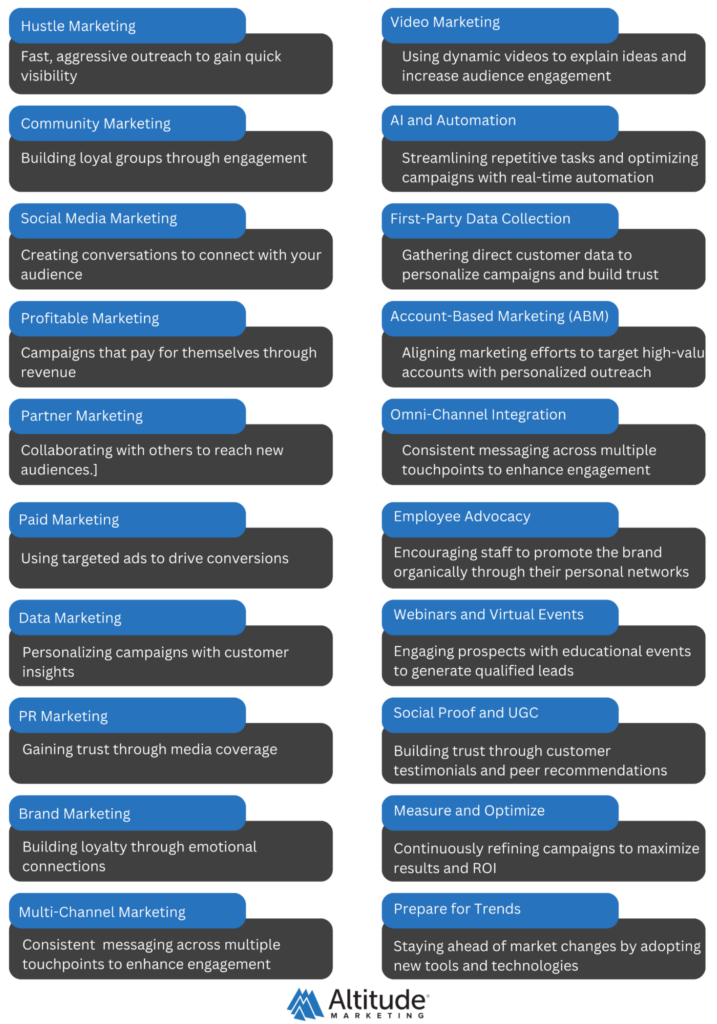In 2025, B2B marketing demands innovative approaches, combining creativity, technology, and data-driven strategies to stay relevant in a competitive environment. With 41% of B2B professionals expecting an increase in their marketing budgets for 2025, businesses must navigate longer sales cycles, engage multiple stakeholders, and meet rising personalization demands. To achieve sustainable growth, companies need to leverage a variety of tactics to build relationships and stay ahead. In this article, we will explore 20 actionable strategies that will help position your brand for long-term success.


1. Hustle Marketing for Maximum Exposure
Hustle marketing focuses on bold, aggressive outreach across multiple channels to generate immediate brand visibility. It leverages guerrilla marketing and creative campaigns to cut through the noise in competitive markets. This strategy is ideal for companies needing fast, noticeable traction.
How to Execute:
- Use cold calls, email campaigns, or direct SMS to engage prospects quickly.
- Incorporate guerrilla tactics like branded pop-up events or street activations.
- Leverage social media for spontaneous promotions or limited-time giveaways.
For example, a SaaS company offers a free trial for users who scan a QR code during an industry event, creating urgency and capturing immediate leads. Hustle marketing ensures your brand stays visible, agile, and active, creating a buzz even with minimal budgets.
2. Community Marketing to Build Loyal Fans
Community marketing builds a dedicated audience by fostering engagement within a connected group of customers or enthusiasts. It promotes long-term loyalty by creating a sense of belonging and positioning the brand as a valuable resource.
How to Execute:
- Create private forums, Slack channels, or LinkedIn groups for user interaction.
- Host exclusive events, virtual meetups, or product previews for members.
- Offer loyalty rewards and incentives to encourage ongoing participation.
For example, a consulting firm builds a LinkedIn community where users share industry insights and receive early access to reports. Community marketing turns fans into advocates who amplify your brand through word-of-mouth promotion.
3. Social Media Marketing with Engagement Focus
Social media marketing prioritizes interaction over promotion by focusing on two-way conversations with customers. This strategy builds trust, increases brand visibility, and fosters deeper connections with your audience.
How to Execute:
- Conduct polls, live Q&A sessions, or contests to invite interaction.
- Share behind-the-scenes moments, customer success stories, or helpful tips.
- Post engaging content consistently to maintain momentum and brand awareness.
For example, a software company hosts weekly LinkedIn polls about industry trends and awards branded swag to participants. Social media marketing builds stronger connections with followers, encouraging them to engage more meaningfully over time.
4. Profitable Marketing that Pays for Itself
Profitable marketing focuses on generating measurable returns, ensuring every campaign contributes directly to revenue. It uses strategies like retargeting, conversion tracking, and lead scoring to drive self-sustaining growth.
How to Execute:
- Implement PPC campaigns with optimized landing pages for conversions.
- Use retargeting ads to re-engage leads and drive them toward purchase.
- Track Customer Acquisition Costs (CAC) and Lifetime Value (LTV) to measure performance.
For example, an eCommerce tool runs retargeting campaigns that recover the cost of ads by converting abandoned cart users into paying customers. Profitable marketing ensures that campaigns fund themselves, making your marketing engine more sustainable over time.
5. Partner Marketing for Amplified Reach
Partner marketing leverages collaborations with complementary businesses or influencers to expand your audience. By aligning with partners, businesses can tap into new networks and boost credibility.
How to Execute:
- Co-host webinars or produce joint content with industry partners.
- Develop affiliate programs that incentivize partners to promote your products.
- Launch co-branded campaigns or bundle complementary services.
For example, a cybersecurity company partners with a cloud services provider to offer a joint security solution for remote teams. Partner marketing broadens your reach while sharing resources and risks with collaborators.
6. Paid Marketing with Targeted Ads
Paid marketing helps businesses reach their ideal audience efficiently by using platforms like LinkedIn and Google Ads. This approach allows for precise targeting, ensuring you engage decision-makers within your niche.
How to Execute:
- Use account-based targeting to focus on key industries or companies.
- Create personalized ad content for different job roles or regions.
- Monitor metrics like click-through rate (CTR) and cost-per-lead (CPL) for optimization.
For example, a software company runs LinkedIn ads targeting healthcare CFOs to promote financial planning tools. Paid marketing maximizes reach and drives conversions by delivering targeted messages to the right audience.
7. Data Marketing for Precise Targeting
Data marketing uses analytics and insights from customer behavior to create hyper-personalized campaigns. It ensures your messaging aligns with audience needs, driving better engagement.
How to Execute:
- Use CRM data to segment email lists based on user activity.
- Analyze browsing behavior to recommend relevant products or content.
- Implement predictive models to forecast lead potential and campaign success.
For example, a CRM provider sends personalized emails offering features tailored to each user’s business needs. Data marketing ensures campaigns are relevant, improving engagement and boosting conversion rates.
8. PR Marketing for High-Impact Exposure
PR marketing enhances credibility by securing earned media coverage. It focuses on positioning your brand as a thought leader through strategic storytelling and media relationships.
How to Execute:
- Issue press releases for product launches or key milestones.
- Build relationships with journalists to gain feature articles.
- Use newsjacking to align your brand with trending conversations.
For example, a fintech startup releases news about a successful funding round, gaining coverage on major industry platforms. PR marketing boosts your brand’s authority and builds trust with potential customers.
9. Brand Marketing to Build Trust and Loyalty
Brand marketing focuses on creating emotional connections with customers by reinforcing brand values and trust. This long-term strategy strengthens customer loyalty and differentiates you from competitors.
How to Execute:
- Share your brand’s story and values through campaigns and content.
- Consistently deliver on brand promises to maintain trust.
- Highlight testimonials, awards, and case studies to showcase credibility.
For example, a consulting firm shares client success stories through blogs and social media. Brand marketing ensures customers feel connected to your mission, fostering long-term loyalty.
10. Multi-Channel Marketing for Seamless Engagement
Multi-channel marketing ensures consistent messaging across various touchpoints, improving engagement and customer experience. It aligns efforts across channels to nurture leads more effectively.
How to Execute:
- Coordinate email, social media, and event campaigns for unified outreach.
- Use automation tools to sync campaigns across channels.
- Provide personalized follow-ups based on user activity.
For example, a SaaS company aligns email campaigns with LinkedIn outreach to follow up after product demos. Multi-channel marketing creates seamless engagement, keeping prospects engaged throughout the buyer journey.
11. Leverage Video Marketing to Drive Engagement
Video marketing increases audience engagement by presenting complex ideas in an accessible and engaging way. It enhances brand connection through dynamic content.
How to Execute:
- Create product demos, tutorials, or customer testimonials.
- Share videos on social media, websites, and email campaigns.
- Host live webinars or interactive Q&A sessions to engage prospects.
For example, a software vendor uses product demo videos on landing pages, helping customers better understand features. Video marketing provides a visual storytelling tool that improves engagement and conversion.
12. AI and Automation for Campaign Optimization
AI and automation streamline repetitive marketing tasks and optimize campaigns in real-time. This strategy ensures efficiency without compromising personalization.
How to Execute:
- Automate lead scoring and email sequences based on behavior.
- Use AI-powered chatbots to nurture leads and provide instant support.
- Implement predictive analytics for more precise campaign targeting.
For example, an AI-powered chatbot captures leads 24/7 by engaging visitors with personalized product suggestions. Automation ensures consistent follow-ups while reducing manual workloads.
13. First-Party Data Collection for Personalization
First-party data collection allows businesses to gather valuable customer insights directly from interactions, ensuring personalized campaigns. This method enhances trust by giving customers transparency over how their data is used.
How to Execute:
- Offer interactive quizzes, surveys, or gated content like eBooks.
- Capture customer data through website behavior and CRM integration.
- Use data insights to personalize campaigns, emails, and product recommendations.
For example, a software company tracks visitors’ activity on its pricing page and follows up with targeted email offers. First-party data empowers businesses to tailor outreach, boosting engagement and trust.
14. Account-Based Marketing (ABM) for Targeted Outreach
ABM aligns sales and marketing efforts to target high-value accounts with personalized campaigns. This approach ensures that outreach resonates with decision-makers, increasing the likelihood of conversion.
How to Execute:
- Identify key accounts and develop personalized messaging.
- Align sales and marketing teams to ensure coordinated outreach.
- Use intent data to track engagement and optimize campaigns.
For example, a cloud services provider runs tailored LinkedIn ads for decision-makers at top-tier companies. ABM ensures high-impact engagement, maximizing ROI by focusing on the most valuable prospects.
15. Optimize Customer Journeys with Omni-Channel Integration
Omni-channel integration creates a seamless customer experience by connecting all touchpoints throughout the buyer journey. This strategy ensures customers receive consistent communication at every interaction.
How to Execute:
- Track customer behavior across channels (email, social, website).
- Use automation tools to synchronize campaigns and nurture leads.
- Align offline and online touchpoints for a cohesive experience.
For example, a B2B company sends follow-up emails to webinar attendees and retargets them with social ads, keeping them engaged. Omni-channel marketing ensures no customer falls through the cracks, increasing conversion opportunities.
16. Employee Advocacy to Amplify Organic Reach
Employee advocacy encourages staff to share brand messages within their personal networks. This strategy boosts brand visibility organically and strengthens credibility through authentic promotion.
How to Execute:
- Provide employees with pre-approved shareable content.
- Use platforms like LinkedIn Elevate to manage advocacy campaigns.
- Incentivize participation with rewards or recognition programs.
For example, a consulting firm runs an employee spotlight series on LinkedIn, where team members share success stories. Employee advocacy extends the brand’s organic reach and humanizes the company.
17. Webinars and Virtual Events for Lead Generation
Webinars and virtual events offer opportunities to engage directly with potential customers, providing educational value while generating qualified leads. This strategy positions businesses as thought leaders.
How to Execute:
- Promote webinars through email campaigns and social media.
- Use polls, Q&A sessions, and live chats to engage attendees.
- Follow up with participants via personalized emails and offers.
For example, a cybersecurity firm hosts a webinar on emerging threats and follows up with participants, offering product consultations. Webinars help nurture prospects by building trust through valuable insights.
18. Social Proof and User-Generated Content (UGC)
Social proof uses customer testimonials, reviews, and user-generated content to build credibility. It taps into the power of peer recommendations, increasing trust among prospects.
How to Execute:
- Showcase customer reviews and testimonials on landing pages.
- Encourage users to share their experiences through social media campaigns.
- Run contests to generate UGC and highlight it in marketing efforts.
For example, a SaaS company shares video testimonials from satisfied customers across social media. Social proof strengthens brand credibility and encourages prospects to make purchase decisions.
19. Measure and Optimize Campaign Performance
Measuring and optimizing campaign performance ensures continuous improvement. Regular monitoring helps businesses refine strategies, maximize ROI, and eliminate inefficiencies.
How to Execute:
- Identify key performance indicators (KPIs) such as CTR, conversion rates, and ROI.
- Conduct A/B testing on emails, ads, and landing pages.
- Use analytics tools like Google Analytics and CRM dashboards to track results.
For example, a B2B firm reviews its email campaign metrics weekly and adjusts subject lines based on open rates. Measuring performance ensures that campaigns are fine-tuned for optimal results.
20. Prepare for Emerging Trends and Technologies
Staying ahead of trends ensures long-term relevance in a constantly evolving market. Businesses that adopt innovative tools and practices position themselves as industry leaders.
How to Execute:
- Monitor industry reports and trend forecasts for insights.
- Experiment with new technologies like AI, blockchain, or AR/VR.
- Train your team to stay updated on the latest platforms and tools.
For example, a consulting firm integrates AI tools for customer segmentation and lead generation. Preparing for emerging trends ensures businesses stay agile, competitive, and ready for future challenges.
Conclusion
By implementing these 20 innovative B2B marketing strategies, businesses can effectively engage audiences, build trust, and drive sustainable growth in 2025. From hustle marketing to leveraging AI and employee advocacy, each approach offers unique value, ensuring relevance in a competitive market. The key to success lies in balancing creativity, data, and technology while building meaningful customer relationships.
FAQ’s On B2B Marketing Ideas
What are the 4 C’s of B2B marketing?
The 4 C’s are Customer Wants and Needs, Cost, Convenience, and Communication, focusing on audience understanding, addressing pain points, and effective engagement.
What is the B2B trend in 2025?
Data management will be critical, with marketers prioritizing data quality, governance, predictive analytics, and integration amidst privacy concerns and tighter regulations.
What is the future of marketing in 2025?
AI will drive digital marketing, but strategic use is key to maintaining authenticity, with personalization rooted in audience understanding and aligned with brand values.
Is B2B eCommerce growing?
B2B eCommerce sales in the US are projected to reach $3 trillion by 2027, increasing from 17% of all B2B sales in 2022 to 24% by 2027.
Ready to elevate your B2B marketing?
We help leading business-to-business brands hit their marketing goals. Get in touch to learn how Altitude Marketing can help you reach your peak performance.



